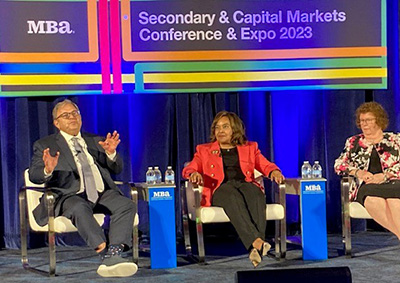
MBASecondary23: How the FHLBs are Evolving in a Changing Market

(Stanley Middleman (l) of Freedom Mortgage with Teresa Bazemore of the Federal Home Loan Bank of
San Francisco and Kris Williams (r) of the Federal Home Loan Bank of Des Moines
at #MBASecondary23 in New York.)
NEW YORK–Not everyone can become a member of the Federal Home Loan Bank System—just ask most independent mortgage banks.
But here at the Mortgage Bankers Association’s National Secondary Market Conference & Expo, Teresa Bryce Bazemore, President and CEO of the Federal Home Loan Bank of San Francisco; and Kristina “Kris” Williams, President and CEO of the Federal Home Loan Bank of Des Moines, Iowa, stressed the importance of FHLB member banks to the secondary mortgage market.
“We see ourselves as business partners with our member institutions,” Bazemore said. “We take different types of collateral under our programs.”
Bazemore emphasized flexibility in working with members. “For example, our window is much larger and longer,” she said. “So, if you want to fund a multifamily project, you can work with us in terms of loan structure—it’s not a one-size-fits-all structure.”
Williams said FHLB underwriting is stringent. “Generally speaking, the FHLBs underwrite their members all the time,” she said. “You must have collateral. We are a collateralized lender, and we check on this regularly. We evaluate our members daily, weekly or monthly depending on the collateral. For securities, it could be daily or weekly. Nearly all of our collateral is real estate-related—multifamily and one-to-four building structures. We value that collateral and we generally take haircuts, which are meant to denote liquidation and changes in the environment during the period in which we fund the transaction.”
“We’re a member cooperative, not a regulator,” Bazemore said. “It’s all about the creditworthiness of our member. We essentially have a line of credit that they’ve already established, so they can come to us and say, ‘we need $1 billion,’ and we already know that they’re pre-underwritten for a certain amount of money.”
Still, problems arise. “The SVB situation was never what we’d seen before,” Bazemore said. “One day, SVB was fine; the next day, it lost $42 million in deposits—26 percent of its deposits in one day. By contrast, Washington Mutual in 2010 lost the same percentage of deposits over a period of three weeks. So this is something to keep a careful eye on.”
In a separate session here at #MBASecondary23, Naa Awaa Tagoe, Deputy Director of the Division of Housing Mission and Goals with the Federal Housing Finance Agency, noted last August, FHFA launched a review of the Federal Home Loan Bank System, to ensure the Banks remain positioned to meet the needs of the communities they serve in the future.
“We asked for feedback on a range of topics, including the mission and purpose of the Home Loan Bank System, membership eligibility and the effectiveness of the system in supporting affordable housing and community development, especially in underserved and financially vulnerable communities,” Tagoe said. “The feedback has been robust. We heard that the System has been a stable and reliable source of liquidity for its members institutions, particularly for smaller members and during times of market stress. This was made clear in March during a period of heightened volatility in the banking sector, when the FHLBanks provided a record amount of advances to ensure their members had the liquidity they needed in an uncertain market.”
So, should mortgage banks be eligible FHLB membership? Bazemore said the notion is not impossible, “but we’d have to give careful consideration about the logistics.”
